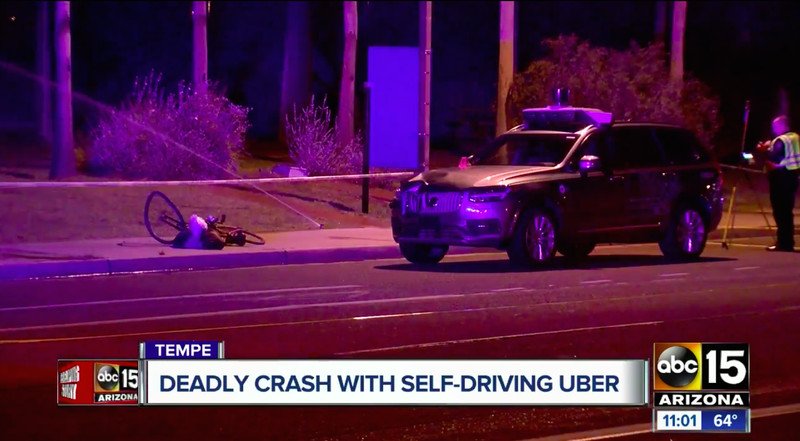Uber’s self-driving car showed no signs of slowing before fatal crash, police say

Uber's self-driving car was traveling at a speed of 40 mph when it struck a 49-year-old woman in Arizona Sunday night, and did not show significant signs of slowing down, police said today.
The pedestrian, Elaine Herzberg, was transported to the hospital, where she later died. Herzberg, who was pushing a bicycle across the street, "may have been" homeless, Tempe Police Sgt. Ronald Elcock said in a press conference. There was a safety driver behind the wheel of the vehicle, identified as Rafael Vasquez, 44. There is no sign that the driver was impaired, policy said. An Uber spokesperson confirmed that Vasquez is employed as a safety driver by the ride-hailing giant. The vehicle was traveling in autonomous mode at the time of the crash.
The crash late Sunday evening has drawn intense scrutiny by the national media. It was likely the first time that a human pedestrian has been killed by an autonomous vehicle. Proponents of the technology have championed self-driving cars as a potential antidote to the tens of thousands of traffic fatalities that occur each year, while some safety advocates have expressed with the speed with which these vehicles are being pushed onto public roads for testing.
Uber suspended all of its self-driving testing in cities across the country in the wake of the crash. Volvo and Toyota, which have self-driving partnerships with Uber (or were negotiating deals), have declined to comment on the future of their relationship with Uber.
The crash is most significant fatal incident involving a self-driving vehicle since a Tesla driver was killed in 2016 while his vehicle was in semi-autonomous Autopilot mode. Arguably this case will be even more scrutinized, as it involved a more advanced vehicle and a more controversial company. The National Traffic Safety Board has dispatched a team to Tempe to investigate.
Herzberg was crossing the street mid-block when she was struck by the self-driving Uber, police said. "The safety of our citizens here in Tempe is of the utmost importance," Elcock said. In reminding citizens to use crosswalks, Elcock added, "None of us ever want to go through this ever again, using the crosswalks will definitely limit this from happening again."
Of course, manufacturers often tout the ability of autonomous vehicles to "see" beyond what normal human drivers can see, thanks to an expensive array of cameras, radars, and LIDAR sensors powering the car's perception. And safe street advocates often bristle at law enforcement's description of crash circumstances that appear to place blame on the victims.
The crash will likely lead to an intense round of finger-pointing among law enforcement, regulators, tech experts, and the auto industry. And since Uber's self-driving cars are roving data recorders, there will be high-level interest in seeing what happens to the footage and crash stats captured by the vehicle itself.
The investigation is going to be similar to those of normal car accidents, Elcock said. Once the investigation concludes, the case will be referred to the Maricopa country attorney who will determine whether to bring charges. When asked to describe what it means to be in "autonomous mode," Tempe police deferred to Uber.
Related News


